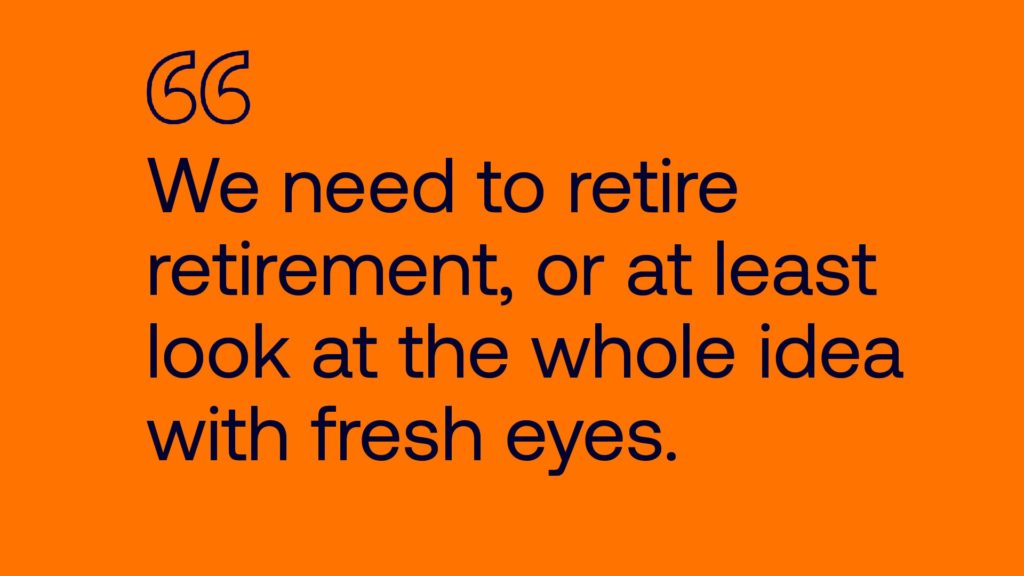How old age is changing around the world
As people live longer and look to retire sooner, many institutions and individuals are rethinking their stance on retirement.
Around the world, life expectancy has reached a record high. People are living longer than ever before – but they’re also retiring sooner. This means that pensioners are collecting benefits for previously unimagined lengths of time.
Millions of baby boomers are moving into retirement at rates of up to 10,000 people a day. Governments are finding that their pension systems lack the resources to keep up with their ageing populations. In response, many have attempted to push back the age of retirement to help balance the scales. However, these efforts are often met with resistance from the public.
As explored in our film, ‘Your Hundred Year Life,’ many governments and companies have started taking different approaches. Ones that encourage, support, and invest in later life workers. These approaches are causing many to rethink the relationship between work and old age. This helps institutions to offset what is quickly becoming a financial black hole. It also benefits older people financially, socially, and mentally.

Helping older workers stay in the workforce
Today, 28% of the Japanese population is over 65 years of age. By 2039, this figure is expected to reach 40%. This means that pensioners will account for nearly half of the country’s population within the next two decades.
In response to the country’s growing pensioner population, some Japanese companies have started offering older staff the opportunity to continue working if they can accept demotion to another role for lower pay. The intention is to give workers the option to perform less stressful and strenuous roles as they get older. Which ensures that anyone who may want to continue to work can do so.
Such was the case for Tsutomu Isonishi, a 70-year-old employee at Shinmei Garage featured in our film. Isonishi was offered a demotion from his managerial role at Shinmei Company once he reached the retirement age of 65. “When I was managing, a day felt longer, but when I do the actual work, a day feels shorter,” he says. While Isonishi’s new role may not be as intense as his previous work, it allows him to earn an income while remaining socially and mentally engaged – both of which are key to maintaining brain health.
In the film, Mara Mather, Professor of Gerontology and Psychology at USC Davis, stresses the importance of maintaining brain health later in life. She explains, “In ageing, we’ve known for a very long time that cognition declined. But there seems to be something called cognitive reserve that has to do with how stimulating your life is.”
Cognitive reserve refers to the brain’s ability to regulate the billions of nerves and connections within the human mind. As we age, it also patches up any links that may be missing. Just as a muscle needs exercise, cognitive reserve must be maintained to keep the brain fit and agile. Therefore, while it may be wise to work less as we get older, it’s just as wise not to quit altogether.
Offering older employees a career change
As demonstrated by Japan, it is possible that the three-stage life model (full-time education followed by full-time work and full-time retirement) may be replaced by a multistage model. People retrain and reskill throughout their working lives.
In the United Kingdom, this is best exemplified by the UK Government’s ‘50 PLUS Champions’ scheme. This scheme, which aims to remove the barriers keeping older workers out of the job market. It has stationed ’50 Plus Champions’ in dozens of communities across England, Scotland, and Wales. Individuals work alongside Jobcentres and Work Coaches to both change employer attitudes about hiring later-life workers and to match jobseekers with opportunities that suit their skills.
The UK is also implementing a Mid-Life MOT service. This supports older workers considering a career change through education opportunities and other forms of support. According to the UK Government, the scheme will also include partnerships between individual businesses and Jobcentres to create sector-based work academies. These swaps will last up to six weeks and will include pre-employment training, work experience with an employer in the industry, and, at the end of the programme, the opportunity to apply for a job interview in the sector or seek help with the application process.
Both the 50 Plus Champions scheme and Mid-Life MOT service have been instrumental in finding placements for later-life workers who have previously struggled to find work. This has been lifechanging for many of these individuals – not only financially, but socially and mentally as well.
For many people, including those featured in our film, going back to work is about more than the money. Working gives them a sense of purpose and allows them to interact with other people and build relationships. This will have a positive impact on their social, mental, and emotional health.
Next steps?
For Larry Kotlikoff, Professor of Economics at Boston University, “The real risk in old age is not dying. The real risk, financially speaking, is living.”
With rising housing rates, the cost-of-living crisis, unparalleled population growth and increasingly unstable pension systems, it’s hard to disagree with Kotlikoff’s assessment.
Be that as it may, Kotlikoff offers a silver lining. People are living longer, yes, but they’re also living healthier. Most older people can still be productive – it’s just a matter of figuring out ways to employ them.
As populations continue to grow, governments and companies must find ways to encourage, support, and invest in older employees. While individuals must reassess their willingness to work later in life – not only for their financial security, but for their social, mental, and emotional well-being.



